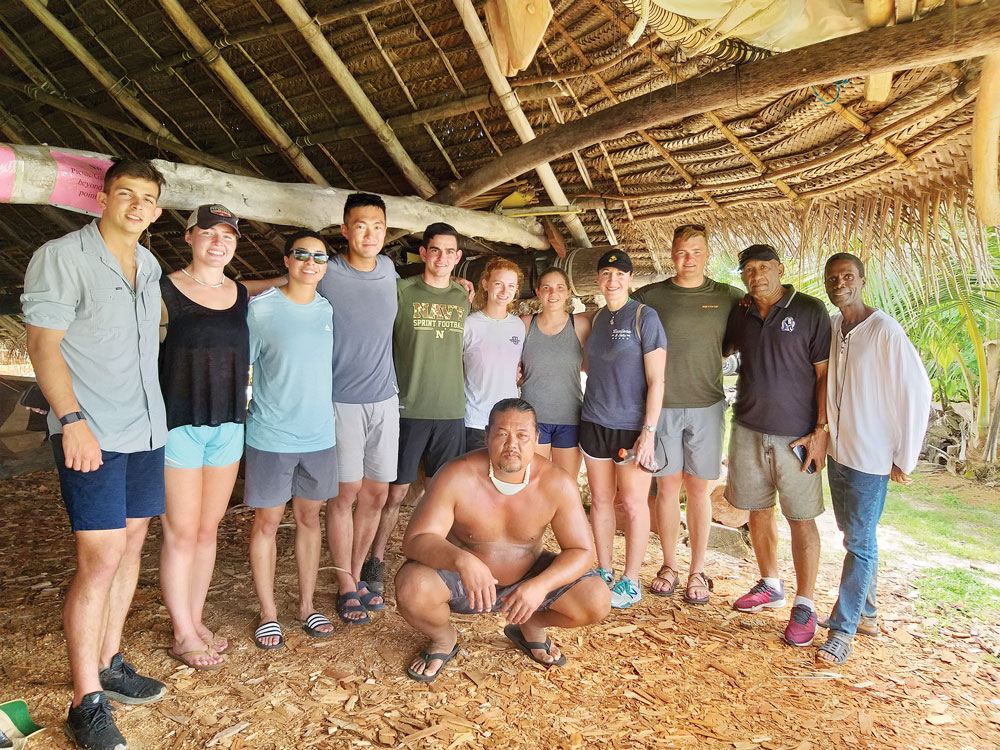Naval Academy cadets soak in culture, history in CNMI visit

John Castro-Mames, front, who is the Canoe Program Coordinator for the Commonwealth Council for Arts and Culture, is joined in this photo by, standing from left, Charlie Sewell, Ellie Dabney, Molly Mangan, Capt. Bob Qu, Aidan Otero, Ava Izenour, Becca Vavasseur, Col. Maria “MJ” Pallotta, Ph.D., Carson Hillier, Willy Kaitabu, and DiscoverSaipan tour guide Walt Goodridge. (Photo courtesy of Walt Goodridge)
A group from the U.S. Naval Academy in Annapolis, Maryland swung by the Canoe/Navigation Project of the Commonwealth Council for Arts and Culture in Susupe yesterday where they learned about the island’s ancient maritime tradition and tried their hand at making a traditional canoe.
The group of nine cadets, composed of a mixed group of sophomores and juniors who are taking part in a Language, Regional Expertise, and Culture Program at the U.S. Naval Academy, is visiting Saipan and Tinian from July 31 to Aug. 5 as part of their battlefield studies and to experience language and culture immersion. Their itinerary includes all-day tours of Saipan and Tinian, which included a pit stop yesterday at the canoe house.
One of the members of the group, Capt. Bob Qu, said the visit to the canoe house allowed them to “observe sort of the cultural aspect of the shipbuilding program.” He met the shipbuilders present to understand their work in terms of reviving the maritime traditions of the islands.
He said they also went on a trek to Forbidden Island and other parts of the island, which showed them the island’s natural beauty on the east side.
Col. Maria Pallotta, who is a reserve with the U.S. Marine Corps, found interacting with island residents to be a pleasant experience. “Everyone has been so friendly to us,” she said. She admits that she did not meet Pacific Islanders until she joined the Marine Corps and was stationed in Okinawa.
Pallota also was impressed to see how celestial navigation between the Navy and master navigators are learned differently. “Seeing them kind of learn the science of what they’ve been doing here in a 4,000-year culture is really, really great,” she said.
The experience reminded her of the other island cultures she visited throughout the Western Pacific and her other travels.
Midshipman First Class Aidan Otero said their visit has made him think that the Marianas in general “has a much bigger role in this world than I gave them credit for.” He said the Marianas has “such a rich culture that we [are]duty-bound to respect.”
Walt Goodridge, who is a part-time tour guide with DiscoverSaipan, said his clientele tend to be older people who are familiar with Saipan’s history of World War II and the Battle of Saipan, “but these guys are actually training to become officers.” He finds them very invested and excited to see where the Battle of Saipan occurred and to understand the culture and its modern life. “They’re very interested in the culture. They want to make sure that they don’t live their lives as outsiders to the region they’re assigned.”
The experience also teaches these potential officers cultural sensitivity and allows them to experience the place where they may be stationed in the future.
“They’re young. They’re energetic and ask tons of questions, and they really immerse themselves in the culture to leave with a very rounded view of life here,” he added.



























